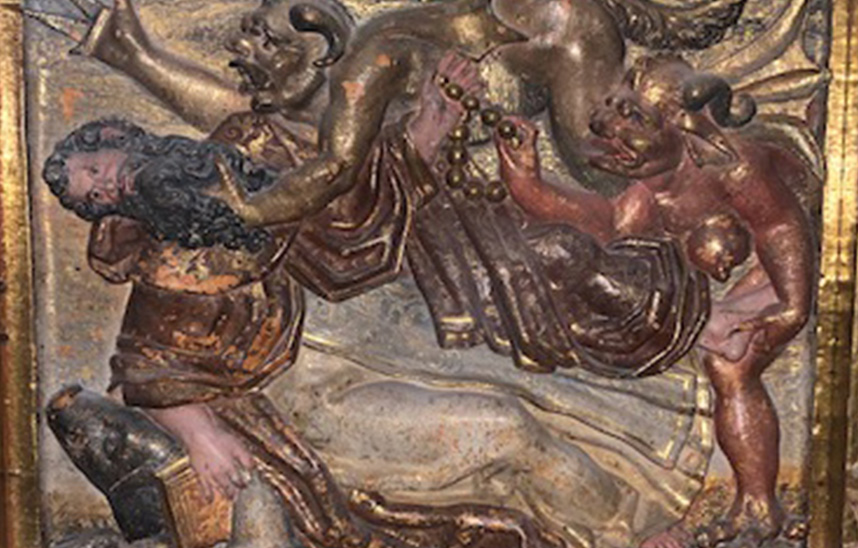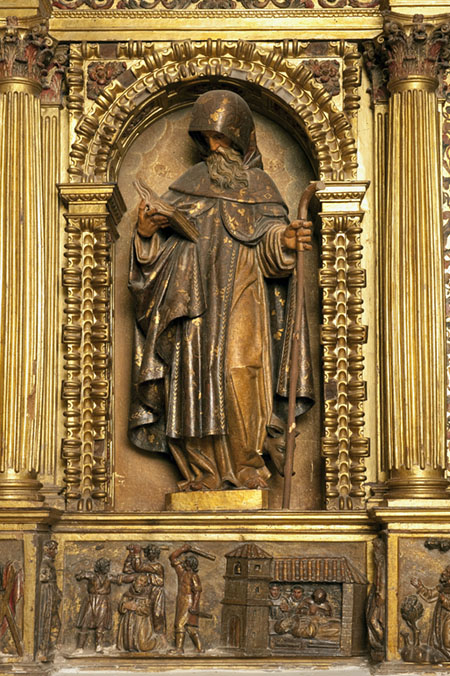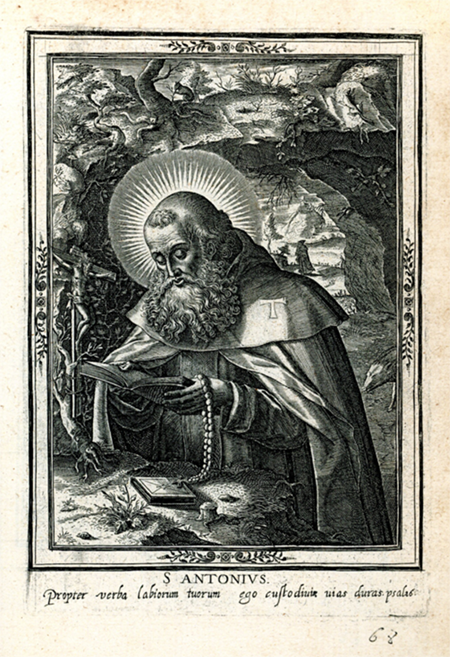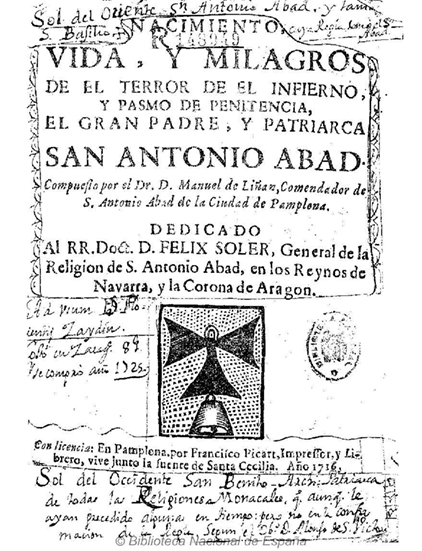Around the images of St. Anton

Photo /St. Anton assaulted by demons, on the bench of the Ilundain altarpiece, late 16th century.
Eremite, penitent, patron of animals and thaumaturge
The life of this spiritual guide of hermits and of the first monasticism, who died in the mid-fourth century, was divulged by St. Athanasius and popularized, like so many others, by Jacobus de la Voragine in the Golden Legend, in the thirteenth century plenary session of the Executive Council , although his cult was already being spread by the Hospitaller Order of the Antonians, who remembered the saint for having distributed his goods among the poor and as a conqueror of many temptations. Towards the end of the Age average, the Antonians cared for the contagious sick, counting among their resources, the breeding of pigs that enjoyed the privilege of roaming the streets with their bells around their necks, being able to root in garbage and communal areas. In some localities, until recent times, the tradition of the "pig of San Antón" was maintained by the neighbors and then raffled.
Among the patronages of the saint are numerous corporations: basket weavers, because the solitary monks of La Tebaida were dedicated to weaving baskets, and gravediggers, because St. Anton buried St. Paul, a hermit in the desert, as we can see in numerous paintings, including one by Velázquez. However, most of his patronages have to do with domestic animals -in relation to the pig, his most popular attribute- and with the healing of the sick, as a healer saint.

San Antón, titular of one of the collaterals of the sanctuary of Nuestra Señora de Codés, work of Bartolomé Calvo (1654). Photo J. L. Larrión
The Antonians stood out for their attention and care of patients with ailments such as plague, leprosy, scabies and especially ergotism, known as "San Antón's fire". They had several establishments on the outskirts of the cities along the Camino de Santiago, where different therapies were practiced, as Juan Ramón Corpas has studied. The aforementioned disease attacked, mostly, the farmers of central and northern Europe, especially during autumn, after a warm and rainy summer, by eating rye bread contaminated by a fungus. In times when many diseases, like this one, had no cure and were attributed to a divine punishment for sins committed, it was advised to do penance and prostrate oneself before the apostle Santiago. Among the therapies of the order were the touches with the Antonian staff and the distribution of scapulars, bread and wine. It should be noted that the mere fact of the change of per diem expenses was fundamental in the healing of many infected, because they, without knowing it, made wheat bread without the parasitic fungus.
The tau and other attributes in its representations
Saint Anthony Abbot is one of the saints who are best identified by the fact that he is always represented as a bearded old man -because he has reached 105 years of age- with a sackcloth and hood, and accompanied by the tau on his clothes and on the abbot's staff, the shearing, the pig and the flames of the "fire of Saint Anthony".
Regarding the tau, it should be remembered that it was interpreted as an apotropaic amulet and preservative against sudden death and contagious diseases. Its origin must be related to the text of Ezekiel that tries to save from death those marked with the tau. The exegetes of the saint interpreted it as a sign of the victories and triumphs that, by virtue of the Holy Cross, Saint Anton achieved over the devil, the hells and fire. Some authors made a curious digression on why the Antonians chose the tau, pointing out that the upper crossbar of the cross of Christ with the INRI should be affiliated with "flowers, kingdoms and glories", not so the other parts of the same, linked to nails, pains, sorrows and torments that the saint wanted to embrace.

Engraving of the saint made around 1600, which is part of the collection of prints of Sister Leonor de Ayanz y Beaumont of the Discalced Carmelites of Pamplona.
The pig at his feet alludes to the dominated lust, coming out triumphant in the numerous temptations narrated in texts and paintings of all schools and periods (Grünewald, El Bosco, Cézanne or Dalí). However, the people always interpreted it as an unequivocal sign of the protection of domestic animals, in times when the life of men depended on them, since they served them as financial aid and food. The pig is a common attribute of gluttony, laziness and lust because it is considered in the Bible as an unclean animal. Cesare Ripa writes: "The pig is the animal most incapable of being straightened, like the slothful, which does not attach any value to anything worthy of praise and is unable to learn anything that requires discipline. Similar to this animal who seeks nothing but to satisfy his appetites of mouth and Venus, the man dominated by laziness abandons himself entirely to the satisfaction of his senses, thus consummating the loss of his own fame."
The bell that accompanies so many children's portraits of past centuries, because it was understood that its sound drove away evil spirits, is assimilated in the case of the saint to the licence of the Antonians to ask for alms from the Roman authorities. It was also an attribute of hermits for its ability to repel the attacks of demons who fled from its noise, as well as from candlelight. The silver bells and the metal shears with the tau were typical of the houses of Antonians, the first for the religious, and the second for the cattle.
We have already referred to the flames of fire when discussing the fire of Saint Anton, although we must also allude to the power that God gave him against fire. Rosary beads, an abbot's staff and the book of knowledge and of the founder complete his iconography. Sometimes, the devil himself, in the form of a monster, appears at his feet, defeated and speared, as did the famous Francisco Salzillo.
Prodigies and wonders in a book published in Pamplona in 1716.
As would be expected in a hagiography of the Baroque period, which bears the rhetorical degree scroll "Nacimiento, vida y milagros del terror de el infierno y pasmo de penitencia ..." (Pamplona, F. Picart, 1716), we find some miracles worked by the saint in the lands of Navarre, along with numerous portentous and fabulous events recounted by its author, the Tudela and Antonian friar Manuel Liñán, and which have been made known by Ricardo Ollaquindia. In particular, he focuses on three cases that occurred in Sangüesa, Caparroso and Tudela. The first one is related to a lady who, ignoring her maid, did not want to keep the feast of the saint with a frustrated laundry when the clothes began to burn. In Caparroso, in 1691, the miracle occurred when a cart with oxen fell down a ravine, leaving the load and animals safe thanks to the invocation to the saint made by several people who saw the event, and in Tudela the miracle occurred when a dreadful fire was suffocated by throwing a picture of the saint into the fire, a very frequent occurrence in other places.

Cover of the book by Manuel Liñán, published in Pamplona by Francisco Picart, in 1716. Library Services National
